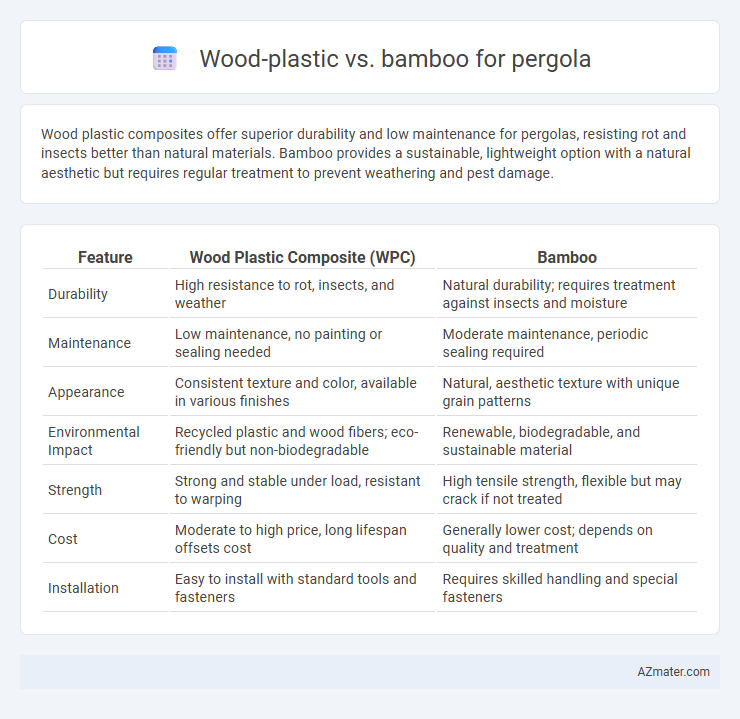Wood plastic composites offer superior durability and low maintenance for pergolas, resisting rot and insects better than natural materials. Bamboo provides a sustainable, lightweight option with a natural aesthetic but requires regular treatment to prevent weathering and pest damage.
Table of Comparison
| Feature | Wood Plastic Composite (WPC) | Bamboo |
|---|---|---|
| Durability | High resistance to rot, insects, and weather | Natural durability; requires treatment against insects and moisture |
| Maintenance | Low maintenance, no painting or sealing needed | Moderate maintenance, periodic sealing required |
| Appearance | Consistent texture and color, available in various finishes | Natural, aesthetic texture with unique grain patterns |
| Environmental Impact | Recycled plastic and wood fibers; eco-friendly but non-biodegradable | Renewable, biodegradable, and sustainable material |
| Strength | Strong and stable under load, resistant to warping | High tensile strength, flexible but may crack if not treated |
| Cost | Moderate to high price, long lifespan offsets cost | Generally lower cost; depends on quality and treatment |
| Installation | Easy to install with standard tools and fasteners | Requires skilled handling and special fasteners |
Introduction to Pergola Material Choices
Choosing the right material for a pergola is crucial for durability and aesthetic appeal, with wood plastic composites and bamboo being popular options. Wood plastic composites offer enhanced weather resistance, low maintenance, and a wood-like appearance, making them suitable for long-term outdoor use. Bamboo provides a natural, eco-friendly alternative with a unique texture and strength, but may require more upkeep to protect against moisture and pests.
Overview of Wood Plastic Composites
Wood plastic composites (WPC) are engineered materials combining wood fibers with thermoplastics, offering enhanced durability and low maintenance compared to natural wood. WPCs resist rot, insect damage, and moisture, making them highly suitable for outdoor structures like pergolas. Their uniform texture and resistance to warping provide a long-lasting, eco-friendly alternative to traditional wood and bamboo.
What Makes Bamboo a Sustainable Option
Bamboo stands out as a sustainable option for pergolas due to its rapid growth rate, often reaching maturity within 3 to 5 years, significantly faster than traditional hardwoods and wood plastic composites. Its natural ability to regenerate without the need for replanting reduces deforestation and soil erosion, making it an eco-friendly building material. Bamboo's high strength-to-weight ratio and resistance to environmental stress enhance durability, ensuring long-lasting pergolas with minimal environmental impact.
Durability: Wood Plastic vs. Bamboo Pergolas
Wood plastic composite pergolas offer superior durability compared to bamboo, resisting rot, insects, and weather damage more effectively due to their synthetic blend. Bamboo pergolas, while eco-friendly and visually appealing, typically require consistent maintenance to prevent decay and insect infestations, especially in humid or wet climates. The long-term resilience of wood plastic materials makes them a low-maintenance choice for pergola structures exposed to varying environmental conditions.
Maintenance and Longevity Comparison
Wood plastic composites (WPC) and bamboo offer distinct advantages in pergola maintenance and longevity; WPC requires minimal upkeep due to its resistance to rot, insects, and weathering, often lasting 15-25 years with only occasional cleaning. Bamboo, while eco-friendly and visually appealing, demands regular sealing and protection from moisture and pests to prevent degradation, generally lasting around 10-15 years under proper care. Choosing between WPC and bamboo involves balancing maintenance effort against desired lifespan and environmental impact for pergola applications.
Aesthetic Appeal and Customization Options
Wood plastic composites (WPC) offer a sleek, modern aesthetic with consistent color and texture, ideal for clean, uniform pergola designs, while bamboo provides a natural, warm appearance with unique grain patterns that enhance rustic or tropical styles. Customization options for WPC include a variety of colors, finishes, and modular components that resist warping and fading, whereas bamboo allows for handcrafted details and organic shapes but may require more maintenance to preserve its look. Both materials cater to distinct design preferences, with WPC suited for contemporary, low-maintenance projects and bamboo favored for eco-friendly, artisan-crafted pergolas.
Environmental Impact and Sustainability
Wood plastic composites (WPC) for pergolas often use recycled plastics combined with wood fibers, reducing landfill waste and promoting circular economy principles, but they rely on non-renewable petroleum-based plastics which can persist in the environment. Bamboo, renowned for its rapid growth rate--up to 3 feet per day--and high carbon sequestration capacity, is a highly renewable resource that regenerates quickly without requiring replanting or deforestation. Choosing bamboo for pergolas supports sustainable forestry and minimizes environmental impact, while wood plastic composites offer durability with some recycled content but face challenges related to plastic pollution.
Cost Analysis: Installation and Long-Term Value
Wood plastic composite (WPC) pergolas typically have a higher upfront installation cost due to specialized fasteners and tools but offer lower maintenance expenses, enhancing long-term value. Bamboo pergolas, while generally cheaper to install, may require frequent treatments against weathering and pests, increasing maintenance costs over time. Evaluating total cost of ownership, WPC pergolas provide greater durability and cost efficiency, whereas bamboo's initial savings might be offset by ongoing upkeep expenses.
Weather Resistance and Performance Outdoors
Wood plastic composites (WPC) offer superior weather resistance compared to bamboo, as WPC materials resist moisture, rot, and insect damage effectively, ensuring durability in varying outdoor conditions. Bamboo, while naturally strong and eco-friendly, tends to absorb water and may warp, crack, or deteriorate when exposed to prolonged moisture and sunlight without proper treatment. For pergolas requiring long-lasting performance under harsh weather, wood plastic composites provide a low-maintenance, resilient solution that retains structural integrity and aesthetic appeal over time.
Choosing the Right Material for Your Pergola
Wood plastic composites offer durability, low maintenance, and resistance to rot and insects, making them ideal for pergolas exposed to harsh weather conditions. Bamboo provides a natural, eco-friendly option with a unique aesthetic appeal but requires regular treatment to prevent decay and insect infestation. Selecting between wood plastic and bamboo depends on your priorities for sustainability, maintenance effort, and desired pergola appearance.

Infographic: Wood plastic vs Bamboo for Pergola
 azmater.com
azmater.com